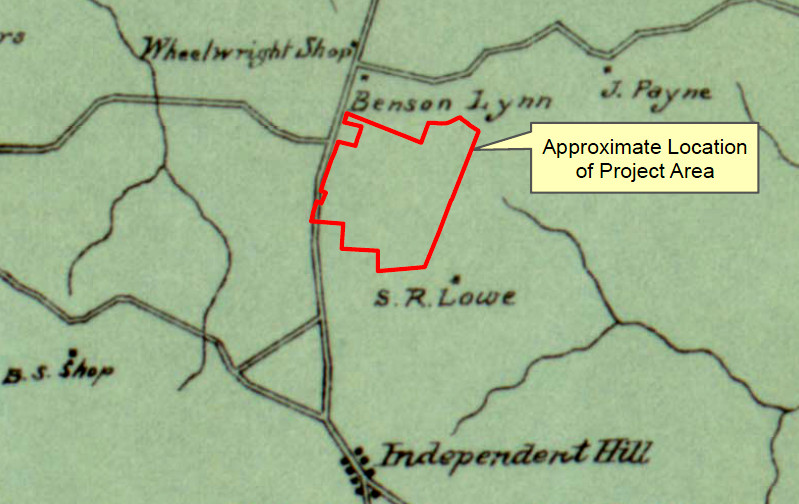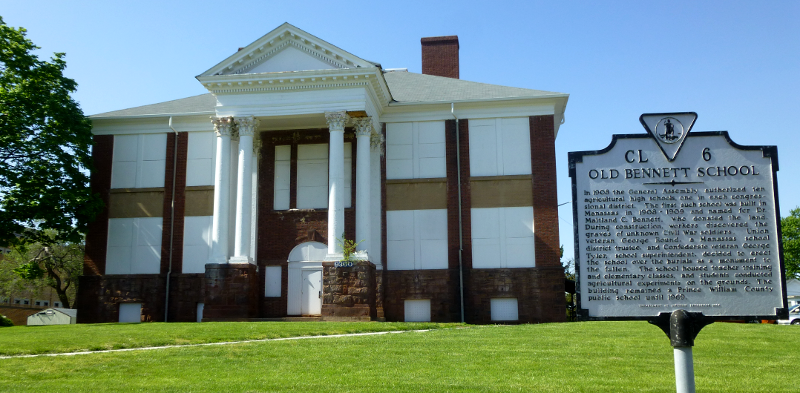 the 1901 Brown Map shows the 12th high school site was between the Lynn and Lowe properties Source: Thunderbird Archeology, Phase 1 Archeological Investigation |
 the 1901 Brown Map shows the 12th high school site was between the Lynn and Lowe properties Source: Thunderbird Archeology, Phase 1 Archeological Investigation |
The news broke in August, 2013, about a cemetery at the site of the 12th high school. The failure to identify the cemetery before detailed site plans were developed, and the process followed by school officials after the discovery of the historic resource at the site, have spurred public discussion.
In 2008, the School Board went through the Public Facility Review process and obtained approval from the Planning Commission to build a new high school near the intersection of Hoadley Road and Route 234.
The Public Facility Review process did not require any research regarding historic resources at the site, which should have revealed the existence of the cemetery and shaped the design of the new high school. Instead, planning documents included a statement regarding protection of Cultural Resources that might be discovered on the site: "A Phase I study will be completed and Phase II Evaluations and Mitigation provided if necessary."1
 commitment for cultural resources assessment in Public Facility Review - but the county accepted incomplete Phase 1 research from the contractor (the woods were too thick to explore...) Source: Prince William County Department of Planning, Planning Commission Staff Report for Public Facility Review #PLN2008-00321, 12th High School |
School officials planned the location of buildings and athletic fields to minimize impact to a nearby stream - but without consideration of any historic impacts. The contractor for the Phase I cultural resource assessment, Thunderbird Archeology (a part of Wetland Studies and Solutions Inc.), failed to find the cemetery through research into historical records at the county library or through on-site investigation.
The cemetery (now listed with the Virginia Department of Historic Resources as site 44PW1947) was discovered by surveyors perhaps as early as 2008, and certainly in 2013. Its existence was reported by InsideNova in August, 2013. The cemetery was located in thick woods with small fieldstones marking the graves.
After the existence of the cemetery was revealed in news stories, school officials discussed the situation with members of the county's Historical Commission and others. However, it was just an exercise of going through the motions, while the school officials quietly obtained approval from the Virginia Department of Historic Resources to move the graves.
The state agency did not question the quality of the research supporting the disinterment request, which failed to identify any family associated with the graveyard. That omission allowed to school system to claim it could bypass the requirement to contact relatives before disinterring graves.
|
School officials had contractors dig up the historic cemetery on Veterans Day and purchased reburial sites far away at Stonewall Memorial Gardens. The excavations were completed while local historians were connecting the dots; they quickly linked the graves to the Lynn family. The official public notice of disinterment plans had been posted in the lobby of the School Board's headquarters and published as a legal notice in the Washington Post, but as a member of the School Board noted later "If I wanted to hide something in plain view, I think the legal notes section of the Washington Post would be about the best place..."2
In November, Historic Prince William awarded its first Bulldozer Award to Prince William Public Schools, for its failure to protect the cemetery and for its lack of transparency in the process of excavating the graves. |

|
The School Board held a special meeting on December 16, 2013 to gather information from the public on how to deal with the graves. Lynn family members were acknowledged by the School Board and most speakers were related to the family, discussing the option of where to reinter the excavated remains and burial artifacts. The school system purchased gravesites at Stonewall Memory Gardens near Gainesville, but Lynn family members encouraged reburying the remains near the site of the original graveyard.
School officials noted that they did not expect to recover DNA, and could not positively connect the cemetery with William Lynn (who died in 1862) and his wife Cordelia (who died in 1889). The final report, issued in June 2014, confirmed that DNS identification was not feasible, and even the number of burials (9-11) was not certain.3
The focus of the Board of County Supervisors has been on improving the Public Facility Review (PRF) process by which new schools are approved. After the Planning Commission objected to plans to add trailers to Brentsville High School without expanding bathrooms or upgrading any infrastructure, the supervisors had streamlined the approval process and reduced oversight by other county officials. After school officials designed the 12th High School without requiring the contractor to complete the promised Phase I archeological study, several members on the Board of County Supervisors suggested the PFR process needs to be strengthened.
At the state level, Del. Rich Anderson (R-51) introduced HB 997 Cemeteries; procedure for removal and relocation of human remains in the Virginia General Assembly. It passed (93-0 in the House of Delegates) and was signed into law by the governor in April, 2014.
The Committee of 100 held a Can You Rest in Peace in Prince William County? program in January, 2014, and one speaker was the acting Director of the Virginia Department of Historic Resources. Six months later, no action had been taken at the local level; the county supervisors have not revised the Public Facility Review (PRF) process. However, one supervisor did make a special effort that Spring to involve the public regarding graves near the Coles fire station that might be moved.
1. Prince William County Department of Planning, "Planning Commission Staff Report for Public Facility Review #PLN2008-00321, 12th High School," Page B-1, http://www.pwcgov.org/planning/documents/PLN2008-00321.pdf
2. Prince William County School Board, November 19, 2013 School Board meeting (see minute 160), http://www.pwcstv.com/episode.php?id=1702
(see minute 160 in the recording of the November 19, 2013 School Board meeting)
3. "Exhumed remains may stay on site of Prince William's 12th high school," InsideNOVA, December 17, 2013, http://www.insidenova.com/news/education/exhumed-remains-may-stay-on-site-of-prince-william-s/article_5c09afd4-6742-11e3-a56b-0019bb2963f4.html; "Report: Remains at high school site likely to remain a mystery," Inside Nova, June 5, 2014, http://www.insidenova.com/headlines/report-remains-at-high-school-site-likely-to-remain-a/article_2493b86e-ecb8-11e3-8dc0-001a4bcf887a.html; "Site 44PW1947 – Cemetery Investigations: Boundary Delineation and Archeological Removal of Human Remains," Wetland Studies and Solutions, May 2014, https://file.ac/yglQItpgb3I/
 according to Yesterday's Schools by Lucy Phinney (p.81), excavations for building Bennett School in 1914 revealed Civil War burials - and the graves were left in place, with the school built on top |